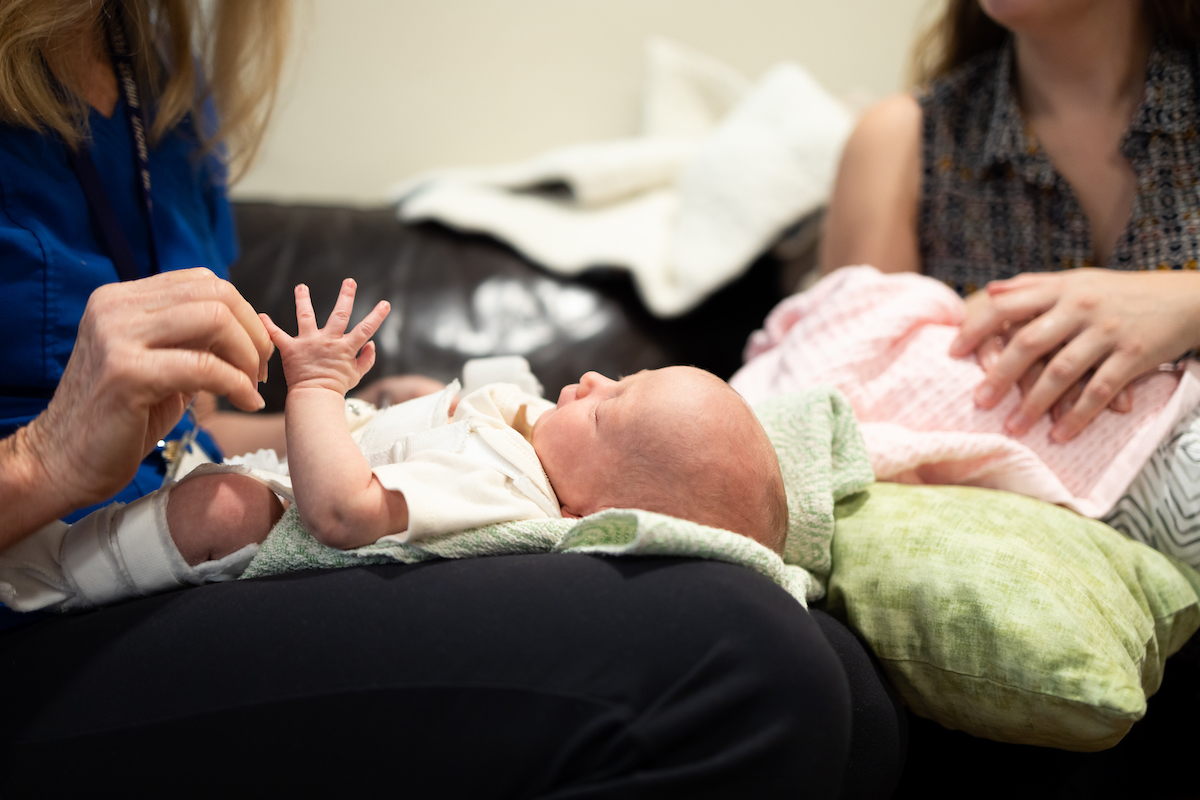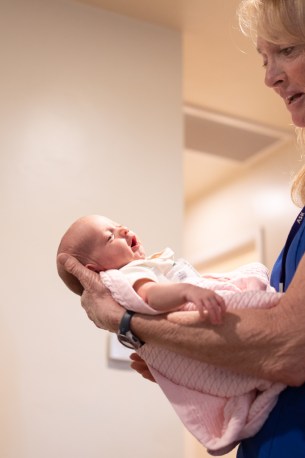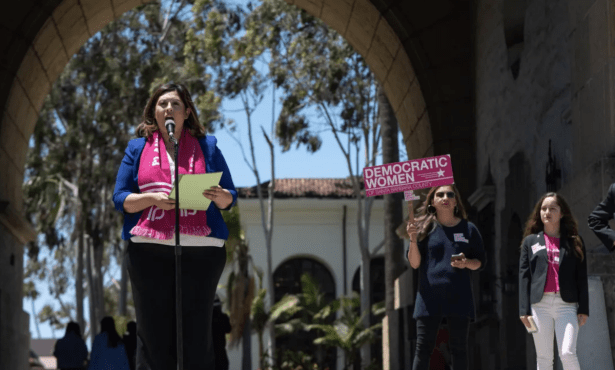Popular At-Home Nurse Program for New Santa Barbara Families to End
Welcome Every Baby, a Free Postpartum Service for 22 Years, Will Stop Care June 30

Cecilia Sousa spent her whole life babysitting, so she was very confident in her childcare abilities. “I thought I knew everything,” she said.
But soon after she left the hospital with her own baby boy, Sousa realized she needed more help learning how to nurse, a common discovery for first-time moms. She pulled herself out of bed, still bleeding, to visit a lactation specialist at their office; however, their one-size-fits-all advice proved unfruitful once she tried putting it into practice at home.
As the minutes and hours ticked by, Sousa began to worry she would never make it work. Her son was losing weight and showing little interest in eating. Panic and anxiety set in. “The hormones, the feeling of helplessness, the rawness of it all ― it was pretty intense,” she said.
That’s when Sousa got a call from Traile Easland, a registered nurse and the longtime leader of Welcome Every Baby, a free postpartum home visitation program that serves Santa Barbara County. Easland stopped by the next day and sat on Sousa’s bed with her. She helped clear a space on the cluttered dresser for a scale to weigh her son before and after feedings.

Over the next couple of hours, Easland showed Sousa different latching techniques and body positions, figuring out what worked best for the pair. She also conducted full health assessments of mother and baby, talked with Sousa about mental health, and developed a game plan going forward.
“Traile came into our home totally free of judgment and empowered us to figure it out together,” said Sousa, the business manager of a UCSB research department. “She took the time. The fact that Welcome Every Baby nurses provide such critical support during such a vulnerable time is really special.”
On June 30, after 22 years of supporting thousands of other Santa Barbara families, the Welcome Every Baby (WEB) program will end. A lack of funding is to blame, explained Easland in a recent interview, describing the loss as yet another example of America’s broken healthcare system. “I’m embarrassed and ashamed of what’s happening,” she said. “I had more rights and services available to me when I had kids 20 years ago.”
Easland and WEB’s four part-time nurses currently see around 550 families annually, she said, and the program costs approximately $350,000 to operate. It’s been available to anyone and everyone, including those who can’t afford a postpartum doula or private lactation consultant, as well as residents who don’t qualify for assistance through the county’s Public Health Department.
WEB has long struggled to secure consistent funding, Easland said, with monies at various times coming from First Five, the Bower Foundation, and other organizations. Grants and donations have also helped make ends meet. WEB recently applied to become a state-licensed home health agency, Easland said, but were denied because they operate under the umbrella of the County Education Office and are technically classified as a school district. They’ve also tried unsuccessfully to secure partnerships with local healthcare entities who could bill insurance companies on their behalf.
“We have met with every possible player in town,” including Cottage Health, Sansum Clinic, and Planned Parenthood, said Easland. Approximately 70 percent of WEB’s clients are Sansum patients, she estimated. “I’ve been very vocal and very clear that this program will go away.” Easland also recently spoke before the Board of Supervisors. Why WEB wasn’t saved before it was allowed to lapse, she doesn’t know. “I don’t have an answer for that,” she said.
When asked about possible replacement services, of which there currently are none, Santa Barbara’s three largest reproductive healthcare providers gave the following statements:
“We are aware that the WEB program is being discontinued at the end of the month and appreciate the teams and caregivers who have served families by providing postpartum home visits,” said Cottage Health spokesperson Bob Behbehanian. “To help fill the gap, Cottage Health has been collaborating with community organizations on planning an updated program for the future.”
Sansum spokesperson Jill Fonte said, “We have always appreciated the WEB program and the valuable support their team has provided to families throughout the County. We are encouraged to know there are groups within our community who are considering ways to continue the services WEB offers.”
Jenna Tosh, CEO of Planned Parenthood California Central Coast, explained her organization is actively working with local funders and partners to develop a new home-visitation model. “Our reproductive health mission includes improving maternal and infant health outcomes and closing disparities,” she said.
Dr. Katrina Mitchell, WEB’s medical director, echoed Easland that the demise of the program is emblematic of the country’s overburdened medical system. “It was providing a key safety net since we simply don’t have enough doctors or nurses or support staff,” she said. “It’s a massive crisis.”
Mitchell said WEB was especially important for infants and parents during that precarious time between hospital discharge and their first OBGYN and pediatrician appointments, typically weeks out. “What we’re losing is that immediate follow-up,” she said, emphasizing WEB’s registered nurses are credentialed not only in lactation support but also in screening for postpartum mood and anxiety disorders. And, Mitchell reiterated, it’s free. “Their absence is really going to be felt,” she predicted.
Oftentimes during their visits, Easland said, the nurses would hear from new mothers about a lack of local resources, especially among those who don’t have relatives living nearby. “There are a whole lot of families who don’t have people automatically checking in on them, asking them how they’re doing,” said Easland.
Sousa, whose son is now five months old, said she was devastated to hear WEB is shutting down. “It’s the bare minimum of what women need,” she said. “And now it’s going away. A lot of moms are heartbroken over this.”
Natascha Cohen is one of them. “It’s such a shame,” she said. Cohen also struggled to nurse her eight-week-old and also benefited from WEB’s personalized care and expertise. “Other countries have support like this built in,” she said. “I’m really hopeful there are other providers in town who will take it on.”
Rachel Walsh, who gave birth earlier this month, will have to find a new source of comparable care after a visit from Easland over the weekend. Easland helped Walsh with the stiff brace her daughter must wear due to hip dysplasia and caught Walsh’s high blood pressure before it became a serious concern. Walsh said she appreciated Easland also checking in with her husband and his emotional well-being.
One of the most difficult parts about WEB ending is feeling like they’re leaving families in the lurch, said Easland. “It’s so hard to just turn our backs,” she said. “We’re scrambling for ways to still help.” And the major question remains: Who should be responsible for paying for these basic health and human services? “This is a community concern,” Easland said. “It’s not just an individual concern.”
The Santa Barbara County Education Office will host a farewell and special recognition event for Welcome Every Baby nurses on Tuesday, June 27, at 11:30 a.m. at the office’s 4400 Cathedral Oaks Road campus.




You must be logged in to post a comment.